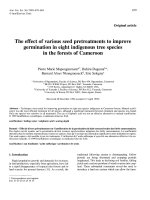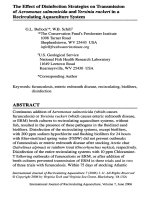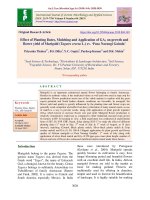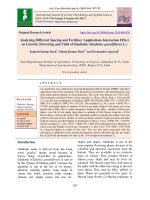Studies on the effect of planting dates and levels of pinching on growth, flowering and yield in marigold (Tagetes erecta) cv. Arka Agni
Bạn đang xem bản rút gọn của tài liệu. Xem và tải ngay bản đầy đủ của tài liệu tại đây (232.77 KB, 9 trang )
Int.J.Curr.Microbiol.App.Sci (2018) 7(11): 2705-2713
International Journal of Current Microbiology and Applied Sciences
ISSN: 2319-7706 Volume 7 Number 11 (2018)
Journal homepage:
Original Research Article
/>
Studies on the Effect of Planting Dates and Levels of Pinching on Growth,
Flowering and Yield in Marigold (Tagetes erecta) cv. Arka Agni
K. Jyothi1*, CH. Raja Goud1, A. Girwani2 and T. Suresh Kumar3
1
College of Horticulture, SKLTSHU, Rajendranagar, Hyderabad-500030 Telangana, India
2
College of Horticulture, SKLTSHU, Mojerla, Telangana, India
3
Horticulture Research Station, Kondamallepally, Nalgonda, Telangana, India
*Corresponding author
ABSTRACT
Keywords
Marigold, Pinching,
Planting dates, Growth,
Flowering, Yield
Article Info
Accepted:
22 October 2018
Available Online:
10 November 2018
An field experiment was conducted to study the effect of planting dates and pinching
levels on growth, flowering in African marigold cv. Arkaagni under open condition. The
experiment was laid out with twelve treatment combinations at College of Horticulture,
Rajendranagar, Hyderabad during 2017 - 2018, with four planting dates and three levels of
pinching. 2nd fortnight of October planting resulted in more plant spread, primary and
secondary branches per plant and also increased several floral characters like flower
diameter, number and weight of flowers per plant and yield per hectare. Shoot pinching at
32 days after planting improved plant spread, number of leaves, as well as weight of
flowers per plant, diameter, number of flowers per plant and yield of flowers per hectare.
Interaction effect of 2nd fortnight of October planting with double pinching was found
beneficial in improving flower yield per hectare
Introduction
Marigold is one of the most important
commercial flower crops grown world over,
accounting for more than half of the nations in
loose flower production. It has gained
popularity due to easy cultural practices, wide
adaptability,
profuse
flowering,
short
juvenility, large blooming period, relatively
problem free nature, attractive colors, shape,
size and good keeping quality. The area under
commercial cultivation in India is on the rise
owing to its multipurpose use. Flowers are
widely used for making garlands, floral
decoration, flower baskets, religious offerings,
bedding and potting and also for making
different products (Swaroop et al., 2007). It is
suitable for pigment extraction, natural
colourant preparation oil extraction and other
value addition products etc., which can help
the farmers for maximizing their farm income.
Though, quality of flower and yield is
primarily a genotypic trait, it is greatly
influenced by the prevailing environment
during its growth period. Among other
cultural requirements for proper growth and
flowering of marigold, planting date is the
most important factor which ensures the
flower yield and its quality. Flower yield is
mainly dependent on number of flower
bearing branches which can be manipulated by
2705
Int.J.Curr.Microbiol.App.Sci (2018) 7(11): 2705-2713
arresting the vertical growth of plants and
encouraging side shoots by means of apical
bud pinching. Such side shoots would provide
more scope to bear flowers and in turn
contribute for higher flower yield. The
demand for marigold exists throughout the
year for various religious and social functions.
So, for maximizing yield proper time of
cultivation and stage of pinching is necessary.
Materials and Methods
The experiment was conducted during rabi
2017 - 18 to study the effect of dates of
planting and different levels of pinching in
marigold cv. Arkaagniat student farm, College
of Horticulture, Rajendranagar, SKLTSHU,
Hyderabad.
The experiment was laid out by adopting
factorial experiment in randomized block
design with two factors. The land was brought
to a fine tilth by repeated ploughing and
harrowing. All the weeds and stubbles of
previous crop were completely removed. The
spacing was 60 cm x40 cmwas maintained and
all the agronomic package of practices along
with plant protection measures was followed.
There were four different dates of planting i.e.,
D1-2nd fortnight of September, D2-1st fortnight
of October, D3-2nd fortnight of October, D4- 1st
fortnight of November. Three levels of
pinching corresponding to each date of
planting.P0 – No pinching, P1 – Single
pinching at 20 DAT, P2 – Double pinching at
12 days after 1st pinching. The observations
were recorded on five randomly selected
plants per treatments and replication.
Results and Discussion
The data pertaining to the vegetative growth
and flowering characters of marigold cv.
Arkaagni are presented in Tables 1 and 2
respectively.
Effect on growth characters
Plant height was maximum under D1 2nd
fortnight of September planting (53.65 cm)
closely followed by D3 (2nd fortnight of
October) planting (50.61cm). The increase in
plant height with September planting might be
due to prevailing of congenial environmental
conditions such as photoperiod and
temperature for growth of Marigold. Similar
results were reported by Yadram et al., (2015)
in African marigold and Prasad and Reddy
(2003) in China aster. Tallest plant observed
in no pinching P0 (52.94 cm) and minimum
plant height of (46.72cm) was noticed with P2
(Double pinching) which is in conformity with
the result of Singh and Arora (1980) in
marigold and Sehrawat et al., (2003) in
marigold.
The maximum number of primary and
secondary branches are D3 2nd fortnight of
October
planting
(9.12
and
14.09)
st
respectively. While D4 (1 fortnight of
November) recorded the minimum (7.26 and
9.82) respectively. Similar results were
reported by Jane et al., (2001) in
chrysanthemum and Hazarika et al., (2003) in
African marigold. The data on number of
primary branches and secondary branches per
plant were found to be significantly influenced
by different pinching levels. The maximum
Number of primary and secondary branches
was noticed in P2 (8.98 and 13.93)
respectively. As the apical dominance is
removed the plant itself usually adjusts to
encourage the growth of auxiliary buds which
may be converted to branches. Similar results
were also found by Habiba (2012) in different
flowering plants. Plant spread (N–S and E–S)
was maximum in D3 (2nd fortnight of October)
planting (37.62cm, 36.55cm) and minimum
was recorded in D4 (1st fortnight of
November) (31.67cm, 31.17 cm) respectively.
This might be due increase in number of
primary and secondary branches per plant.
2706
Int.J.Curr.Microbiol.App.Sci (2018) 7(11): 2705-2713
The results are in conformity with the findings
of Lakshmi et al., (2014) in African marigold.
Pinching had significant effect on plant spread
in E –W and N – S direction. Among different
pinching treatments, P2 (Double pinching) at
32 DAT recorded significantly highest plant
spread (37.69 cm and 36.68 cm) and minimum
in single pinching (31.42 cm and 31.39 cm)
respectively. Similar results were also
recorded by Maharnor et al., (2011) in
marigold and Mohanty et al., (2015) in
African marigold.
The data recorded on growth parameters
presented in Table 2 revealed that various
combinations
of
planting
time
and
pinchingD1P0 (2nd fortnight of September +
No pinching) recorded the highest plant height
of (57.88cm) and minimum was recorded in
D4P2 (1st fortnight of November + Double
pinching) (41.18 cm) whereas plant spread in
both direction (E-W and N-S) D3P2 (2nd
fortnight of October + Double pinching)
treatment combination was maximum (38.40
cm, 39.13cm) respectively. However, plant
spread of various combinations could not
bring any significant change.
Effect on floral characters
The data recorded on floral parameters
presented in Table 1 revealed planting time
had significant influence on the number of
days taken to 50% flower bud appearance D4
(1st fortnight of November) planting recorded
significantly highest number of days
(46.71days) followed by the D1 (2nd fortnight
of September) minimum number of days
observed in D3 (40.71 days). These results are
in conformation with the findings Samantaray
et al., (1999) in marigold. Among different
pinching levels, P2 (Double pinching)
recorded significantly highest number of days.
The lowest number of days to first flowering
was observed in P0 (39.54 days). By removal
of apical portion, the plants continued the
vegetative phase and the new shoots which
emerged on the pinched plants took longer
time for physiologically mature and flower
bud initiation. These results are in close
conformity with earlier reports of Sehrawat et
al., (2003) and Beniwal et al., (2003) in
marigold, Srivastava et al., (2005) in
marigold.
Maximum number of days taken for 50%
flower opening was D4 (65.96 days)and
minimum days (56.83 days) observed in D3
(2nd fortnight of October). This results were
conformity with the findings of Lakshmi et
al., (2014) in marigold and Sharma et al.,
(2015) in Gaillardia.
The maximum delay in 50% flowering was
noticed in the treatment (Double pinching) P2
(65.38 days), and minimum number of days
observed in P0 (57.31 days). Pinching helps in
altering the source-sink relationship thereby
advancing the reproductive phase. These
results are in close conformity with earlier
reports
Grawal
et
al.,
(2004)
in
chrysanthemum, Srivastava et al., (2005) in
marigold
Flowering duration had showed a significant
effect of which maximum number of days
(52.07days) taken for flowering is D3 (2nd
fortnight of October) and the lowest number
of days (39.86 days) observed in D4 (1st
fortnight of November) planting. Lakshmi et
al., (2014) in African marigold and Sharma et
al., (2015) in gaillardia, Samantaray et al.,
(1999) in African marigold. The maximum
days taken for flowering duration was noticed
in double pinching P2 (50.48 days) plants,
which was followed by single pinching
P1(47.60 days) and minimum number of days
taken for flowering duration is P0 (42.14 days)
unpinched plants. Similar results were
supported by Srivastava et al., (2002) in
marigold and Khandelwal et al., (2003) in
marigold.
2707
Int.J.Curr.Microbiol.App.Sci (2018) 7(11): 2705-2713
Table.1 Effect of planting dates and Pinching on growth and flowering characters
Treatments
Plant
height
Plant spread
No. of branches
E -W
N-S
53.21
48.23
32.96
36.23
33.27
35.25
Primar
y
8.00
8.63
Secondar
y
11.67
12.82
44.01
42.03
62.77
60.26
44.65
50.39
45.64
48.35
336.85
389.94
6.20
6.29
7.54
8.07
8.38
9.72
13.41
15.54
D3
50.61
37.62
36.55
9.12
14.09
40.71
56.83
52.07
50.51
417.77
6.88
8.29
10.43
16.69
D4
47.60
31.17
31.67
7.62
9.82
46.71
65.96
39.86
44.30
313.52
5.11
7.29
7.74
12.38
S.Em±
0.43
0.52
0.50
0.22
0.40
0.63
0.62
0.46
0.43
4.50
0.25
0.15
0.14
0.21
C.D at 5%
1.28
1.53
1.49
0.65
1.17
1.86
1.84
1.36
1.26
13.21
0.75
0.44
0.42
0.64
52.94
31.39
31.42
7.79
10.07
39.54
57.31
42.14
41.14
322.43
6.54
8.08
8.00
12.79
Single
pinching
Double
pinching
S.Em±
50.06
34.40
34.45
8.26
12.31
42.90
61.67
47.60
47.38
367.36
6.11
7.75
9.08
14.52
46.72
37.69
36.68
8.98
13.93
47.65
65.38
50.48
53.09
403.76
5.71
7.57
10.12
16.19
0.38
0.45
0.44
0.19
0.34
0.55
0.54
0.40
0.37
3.90
0.22
0.13
0.12
0.18
C.D at 5%
1.11
1.33
1.29
0.56
1.02
1.61
1.59
1.17
1.09
11.44
0.65
0.38
0.36
0.55
Factor 1
Dates
planting
D1
D2
of
No. of days
taken
to
50% flower
bud
appearance
No.
of Flowering No. of Wt
of Flower Average
days to duration flowers flowers diamete flower wt
50%
per
/plant
r (cm) (gm)
flower
plant
(gm)
opening
Total
plot
yield
(kg)
Yield /
hectare
(t)
Factor 2
Levels
of
pinching
No pinching
2708
Int.J.Curr.Microbiol.App.Sci (2018) 7(11): 2705-2713
Table.2 Interaction effect of planting dates and levels of pinching on growth and floral characters
Treatments
Plant
height
Plant spread
No. of branches
E -W
N-S
secondar
y
9.12
40.56
58.75
41.92
39.18
287.48
6.44
DXP
No. of days
taken to
50% flower
bud
appearance
No. of Flowering No. of Wt of
flower Avg
days to duration flowers flowers/ diameter flower
50%
per plant plant
(cm)
wt (gm)
flower
(gm)
opening
Total
yield/
Plot
(kg)
Yield
/ ha
(t)
7.67
6.98
11.16
D1P0
57.88
29.42
29.89
primar
y
7.45
D1P1
51.93
32.92
34.24
7.81
12.13
43.54
63.15
43.86
45.11
341.98
6.27
7.56
8.58
13.72
D1P2
49.81
36.55
35.67
8.75
13.77
47.92
66.40
48.19
52.64
381.1
5.90
7.39
9.59
15.34
D2P0
51.26
34.33
33.96
7.8
10.78
38.45
56.86
43.25
42.27
347.80
6.63
8.27
8.69
13.90
D2P1
49.32
35.95
34.86
8.8
13.07
40.81
59.76
52.60
48.89
395.50
6.31
8.00
9.81
15.69
D2P2
44.10
38.40
36.92
9.31
14.62
46.82
64.15
55.32
53.88
426.51
5.94
7.93
10.66
17.03
D3P0
52.71
35.75
34.83
8.59
12.16
35.37
49.48
45.16
44.13
392.31
7.67
8.77
9.97
15.95
D3P1
51.30
36.21
35.69
9.03
13.83
39.33
58.61
54.82
52.25
420.11
6.65
8.09
10.20
16.33
D3P2
47.81
40.90
39.13
9.73
16.29
47.44
62.39
56.23
55.15
440.88
6.34
8.01
11.12
17.79
D4P0
49.92
26.06
27.01
7.34
8.21
43.77
64.16
38.23
38.96
262.12
5.44
7.59
6.36
10.17
D4P1
47.71
32.54
33
7.40
10.21
47.94
65.16
39.14
43.25
311.87
5.22
7.36
7.73
12.36
D4P2
45.18
34.92
35.00
8.12
11.04
48.42
68.57
42.21
50.7
366.57
4.67
6.94
9.13
14.60
S.Em±
0.76
0.90
0.88
0.38
0.69
1.10
1.08
0.80
0.74
7.80
0.44
0.26
0.25
0.37
C.D at 5%
2.23
2.66
2.58
NS
NS
3.22
3.19
2.35
2.18
22.88
NS
NS
0.73
1.11
2709
Int.J.Curr.Microbiol.App.Sci (2018) 7(11): 2705-2713
Significantly higher number of flowers
(50.51) was recorded in D3 (2nd fortnight of
October) planting which was followed by D2
(1st fortnight of October) recording (48.35).
The results are conformity with findings of
Ghosh and pal (2008) in marigold, Smita et
al., (2012) in marigold, Lakshmi et al., (2014)
in marigold. Double Pinching (P2) has
possessed significantly more number of
flowers per plant (53.09), which was followed
by (P1) Single pinch at 20 DAT (47.38). The
lesser number of flowers per plant (41.14)
was recorded in (P0) no pinching plants.
Increase in number of flowers may be due to
the fact that pinched plant induces production
of large number of axillaries shoots resulting
in well-shaped bushy plants bearing more
number of uniform flowers. Similar findings
were found by Pushkar and Singh (2012) in
marigold, Badge et al., (2014) in marigold
and Meena et al., (2015) in marigold.
Maximum weight of flowers per plant (417.77
gm) was observed in D3 (2nd fortnight of
October) and minimum weight (313.52 gm)
of flowers are noticed in D4 planting (1st
fortnight of November). Double Pinching (P2)
has possessed significantly maximum weight
of flowers per plant (403.76 gm) and
minimum in P0 (322.4gm). The results are in
agreement with the findings of Sreekanth et
al., (2006) in marigold and Rajayalakshmi
and Rajasekhar (2014) in marigold.
Flower diameter (6.88 cm) was recorded
maximum in D3 (2nd fortnight of October)
planting and minimum was observed in (5.11
cm) has been observed in D4 (1st fortnight of
November) planting. Similar results were also
reported by Mathad et al., (2008) in China
aster and Sharma et al., (2015) in gaillardia.
Significantly maximum flower diameter (6.54
cm) was recorded in non- pinched plants (P0),
which was on par with pinching at 20 DAT
(6.11 cm) Single pinching (P1) minimum
(5.71 cm) was recorded at pinching 32 DAT
Double pinching (P2). Similar findings were
revealed by Sasikumar et al., (2015) in
African marigold, Rathore et al., (2011) in
marigold.
Total yield per plot was significantly
maximum (10.43 kgs) in D3 (2nd fortnight of
October) and minimum (7.74 kg) was
recorded in D4 planting (1st fortnight of
November). The present findings are in
association with the findings of Sreekanth et
al., (2006), Anil et al., (2015). Significantly
maximum yield of flower per plot (10.12 kgs)
was recorded in Double pinching (P2),
followed by (9.08 kgs) Single pinching (P1).
The minimum (8.00 kgs) was recorded in
Double pinching (P2). The similar results are
quoted by Pawar (2001) in chrysanthemum,
Sharma et al., (2012) in marigold.
Significantly higher flower yield (16.69 t/ha),
which was followed by D2 planting date (1st
fortnight of October) with 15.54 t/ha. The
least flower yield per hectare (12.38 t/ha) was
recorded in D4 (1st fortnight of November)
planting. Double Pinching was the most
productive with 16.19 t/ha flower yield
followed by Single pinching (14.52 t/ha)
whereas, minimum flower yield of 12.79 t/ha
was recorded by P0 non pinched plants.
Similar results were also obtained by Sharma
et al., (2012) in marigold, and Mohanty et al.,
(2015) in African marigold.
The data recorded on floral parameters
presented in Table 2 revealed that interaction
of planting dates with pinching had
significant effect. It was observed that
significantly more number of flowers per
hectare was produced in 2nd fortnight of
October planting and double pinching D3P2
(17.79 t/ha) and minimum flower yield (10.17
t/ha) was recorded in D4P0 treatment
combination. However average weight and
flower diameter was found to be had no
significant influence on various treatment
combination.
2710
Int.J.Curr.Microbiol.App.Sci (2018) 7(11): 2705-2713
Based on the result of the present study it is
concluded that among the four planting dates
tried, 2nd fortnight of October planting
improved several growth characters like plant
spread, number of branches per plant. Also it
was beneficial in improving several floral
characters like diameter, fresh weight of
individual flower, number and weight of
flower per plot and yield of flower. Shoot
pinching in marigold once at 32 days after
planting improved plant spread, primary and
secondary branches per plant. Rather, it was
effective in bringing significant improvement
in number and weight of flower per plot and
yield per hectare. Interaction effect of 2nd
fortnight of October planting with double
pinching at 32 days after planting was found
beneficial in flower yield.
Prevalence
of
congenial
atmospheric
condition with moderate temperature during
2nd fortnight of October planting coupled with
favourable effect of Double pinching in
improving the number of branches per plant
might have contributed significantly for
increased flower number plant and plot under
this treatment combination
References
Anil, K. S, Udit, K and Arun, K. 2015. Effect
of planting date and spacing on
performance of African marigold
(Tagetes
erecta
Linn)
cv.
PusaNarangiGainda under North Bihar
agro-ecological
conditions.
International Journal of Forestry and
Crop Improvement. 6(1):16-20
Badge, S, Panchbhai, D. M and Dod, V.N.
2014. Response of pinching and foliar
application of gibberellic acid on
growth and flower yield in summer
African marigold. Res. on Crops.
15(2):394-397
Beniwal, B.S, Ahlawat, V.P and Rakesh.
2003. Studies on Effect of spacing and
pinching on growth flower production
of Chrysanthemum. Haryana journal of
Horticulture Science. 32 (3-4): 228-229.
Gosh, P and Pal, P. 2008. Performance of
Tagetes erecta Linn. cv. Sirakole as
influenced by planting time and spacing
under West Bengal conditions. Natural
Product Radiance. 7(5):437-443.
Grawal, H. S, Kumar, R and Singh, H. 2004.
Effect of nitrogen, planting time in
Chrysanthemum
cv.
Flirt.
J.
Ornamental Hortic. 7(2):196-199.
Habiba, S.U. (2012). Effect of pinching and
foliar application of growth chemicals
on
growth
and
flowering
of
Chrysanthemum. An M. S. thesis, Dept.
of
Horticulture,
Sher-e-Bangla
Agricultural
University,
Dhaka,
Bangladesh. 60
Hazarika, K, Preethi, H, Paswan, L and
Kalitha, P. 2003. Comparision of dates
of planting and growing conditions on
growth and flowering of African
marigold (Tagetes erecta L.) National
Symposium on recent Advances in
Indian Floriculture. pp13.
Jane, R.N, Kawarkhe, V. J and Jadhao, B.J.
2001. Effect of different dates of
planting on the flower yield of annual
chrysanthemum
(Chrysanthemum
coronarium).
Orissa
journal
of
Horticulture. 29(20): 19-22
Khandelwal, S.K, Jain, N. K and Singh, P.
2003. Effect of growth retardants and
pinching on growth and yield of African
marigold (Tagetes erecta L.). Journal of
Ornamental Horticulture. 6(3):271-273
Lakshmi, Rajesh, K, Pandey, Sheetal Dogra,
Nomita Laisharm, DeepjiBhat, Arvinder
Singh and Shivani Jamwal. 2014.
Studies on effect of planting dates and
spacing in African marigold (Tagetes
erecta L.) Progressive Horticulture
46(1): 149-152.
Maharnor, S.I, Chopde, N, Thakre, S and
Raut, P.D. 2011. Effect of nitrogen and
2711
Int.J.Curr.Microbiol.App.Sci (2018) 7(11): 2705-2713
pinching on growth and yield of African
marigold, Asian J. Hort. 6 (1): 43-45.
Mathad, R. C, Vyankarnahal, B. S and
Despande, V.K. 2008. Influence of
planting dates and picking stages on
seed yield and quality in aster
(Callistephus chinensis Nee) genotypes.
Indian
Journal
of
Agricultural
Research. 42(3):224-269
Meena, Y, Sirohi, H.S, Tomar, B. S and
Kumar, S. (2015). Effect of planting
time, spacing and pinching on growth
and seed yield traits in African marigold
(Tagetes erecta L.) cv. Pusa Narangi
Gainda. Indian J. Agril.Sci. 85(6): 797–
801
Mohanty, C.R, Mohanty, A and Parthi, R.
2015. Effect of planting dates and
pinching on growth and flowering in
African marigold cv. Sirakole. The
Asian J. Hort. 10(1): 95-99
Pawar, S.P. (2001). Effect of pinching on
growth
and
flowering
in
chrysanthemum
(Dendranthema
indicum) cv. PKV Shubhra. M.Sc.
Thesis Dr. PDKV, Akola.
Prasad, G and Reddy, B.S. 2003. Growth and
flower yield of China aster as
influenced by dates of planting.
Haryana. J. Hortic. Sci. 32(2):72-74.
Pushkar, N.C and Singh, A.K. 2012. Effect of
pinching and growth retardants on
flowering and yield of African marigold
(Tagetes
erecta
L.)
cv.
PusaNarangiGainda 2(1): 1-4.
Rajyalakshmi, R and Rajashekar, M. 2014.
Effect of different growth regulators
and pinching on growth and flowering
of African marigold (Tagetes erecta L.)
cv. Pusa Narangi Gainda in different
dates of planting. The Journal of
Research ANGRU. 42(1):52-54.
Rathore, I, Mishra, A, Moond, S. K and
Bhatnagar, P. 2011. Studies on effect of
pinching and plant bio regulators on
growth and flowering of marigold
(Tagetes
erecta
L.).Progressive
Horticulture, 43(1): 52-55
Samantaray, D, Mohanty, C. R and Behera, T.
K. 1999.Effect of planting time and
spacing on growth and flower yield of
marigold (Tagates erecta L.) cv.
’African yellow.’ Indian Journal of
Horticulture. 56(4): 382-385.
Sasikumar, K. V, Baskaran and Abirami, K.
2015. Effect of pinching and growth
retardants on growth and flowering in
African marigold cv. Pusa Narangi
Gainda. J. Horticultural Sci. 10(1): 109111.
Sehrawat, S.K, Dahiya, D. S. Singh, Sukhbir
and Rana, G. S. (2003). Effect of
nitrogen and pinching on the growth,
flowering and yield of marigold
(Tagetes erecta L.) cv. African Giant
Double Orange. Haryana J. Hort. Sci.,
32(1/2): 59-61.
Sen, S. K and Naik, J. 1997.Growth and
flowering response of pinching and
unpinched chrysanthemum to growth
regulators treatments. Indian journal of
Horticulture. 34:86-9
Sharma, A. K. Chaudhary, S.V. S and Bhatia,
R.S. 2012.Effect of spacing and
pinching on regulation of flowering in
African marigold (Tagetes erecta Linn.)
Progressive Agriculture. 12(2):331-336
Sharma, M.K, Parmar, P.B and Singh, A.
2015.Effect of planting dates and
nitrogen on growth, flowering and yield
of gaillardia (Gaillardia pulchella
Fouger) cv. Double Yellow under south
Gujarat
climatic
conditions.
International journal of Botany and
Research. 5(4):1-6.
Singh, J and Arora, J.S. 1980.Effect of
spacing and pinching on growth and
flower production of marigold (Tagetes
eracta L.). cv. AFRICAN GIANT
DOUBLE ORANGE. Proc. National
Seminar on production technology for
2712
Int.J.Curr.Microbiol.App.Sci (2018) 7(11): 2705-2713
commercial flower held at TNAU,
Coimbatore. 85-87
Smita, P, Golliwar, V.J, Panchabhai, D. M,
Prathana, J and Sonali, D. 2012.
Response of African marigold varieties
to different planting time on growth and
yield under vidarbha conditions
(Maharastra). Journal of soils and
crops. 22(1):183-187.
Sreekanth, P, Padama, M, Chandrashekar, R.
and Madhaulety, T.Y. 2006.Effect of
planting time, spacing and Nitrogen
levels on flowering of African marigold
(Tagetes
erecta).
Journal
of
Horticulture. 9(2):97 -101.
Srivastava, S.K, Singh, H.K. and Srivastava,
A.K. 2005. Spacing and pinching as
factors for regulating flowering in
marigold cv. Pusa Basanti Gainda.
Haryana Journal of Horticulture
Sciences. 34(1-2):75-77.
Swaroop, K, Singh, K. P and Raju, D. V. S.
(2007). Vegetative growth, flowering
and seed characters of African marigold
(Tagetus erecta Linn) as influenced by
different growth substances during mild
off seasons. J. ornam. Horticulture,
6(2): 134-136
Yadram, M, Sirohi, H. S, Tomar, B. S and
Sanjay, K. 2015. Effect of planting
time, spacing and pinching on growth
and seed yield traits in African marigold
(Tagetes erecta) cv. Pusa Narangi
Gainda. Indian Journal of Agricultural
Sciences. 85(6):797-801
Yassin, G. Md and Pappiah, C.M. (1990).
Effect of pinching and manuring on
growth
and
flowering
of
chrysanthemum CV-MDU-1. South
Indian Hort., 38(4): 232-233.
How to cite this article:
Jyothi, K., CH. Raja Goud, A. Girwani and Suresh Kumar, T. 2018. Studies on the Effect of
Planting Dates and Levels of Pinching on Growth, Flowering and Yield in Marigold (Tagetes
erecta) cv. Arka Agni. Int.J.Curr.Microbiol.App.Sci. 7(11): 2705-2713.
doi: />
2713








![Effect of different plant growth regulators on shooting of stem cuttings in dragon fruit [Hylocereus undatus (Haworth) Britton & Rose]](https://media.store123doc.com/images/document/2020_01/09/medium_isb1578564896.jpg)
